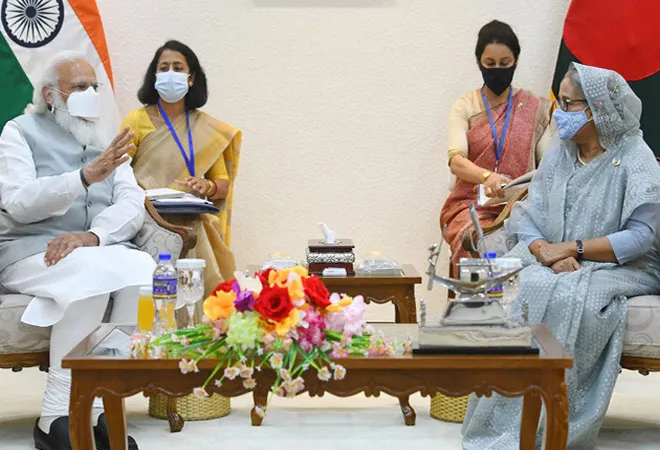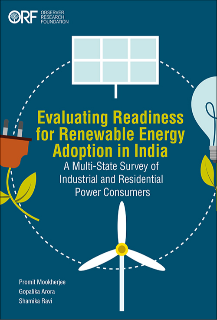
India’s relationship with Bangladesh got a major boost with Prime Minister Narendra Modi’s two-day visit to that country from 26 and 27 March this year. Prime Minister Modi visited Bangladesh on the invitation of his counter Prime Minister Sheikh Hasina to participate in the gala celebration of two epoch events — the golden jubilee of the independence of Bangladesh and the birth centenary of Bangabandhu Sheikh Mujibur Rahman, the iconic leader of Bangladesh’s freedom struggle and first Prime Minister of the country. Notably, the visit was also his first foreign trip after the COVID-19 pandemic that coincided with the 50th year of the establishment of diplomatic relationship between India and Bangladesh. The visit was a celebration of the special bond between the two countries and had set an agenda for the times ahead.
The visit has been a celebration of a common bond because the primary focus of the visit was the golden jubilee of Bangladesh’s liberation, which India actively supported and is considered a common heritage. During Bangladesh’s liberation, India provided shelter to 10 million refugees from that country and had boots on the ground. The presence of Prime Minister Modi in the concluding function of the 10-day gala ceremony celebrating the golden jubilee of the country’s independence and birth centenary of Bangabandhu in Dhaka was the recognition of this common bond. To commemorate this shared history, Bangladesh is constructing a memorial in honour of the martyrs of the Indian Armed Forces who sacrificed their lives in the 1971 Liberation War at Ashuganj in Bramhanbaria. The foundation stone of the memorial was laid during the visit. Additionally, the two countries declared to link the historic road between Mujibnagar and Nadia and naming it as Shadhinota Shorok. India and Bangladesh have decided to celebrate the occasion jointly in remembrance of this common heritage. A prominent initiative in this regard has been the unveiling of the Bangabandhu–Gandhi digital exhibition which will be displayed in 19 countries across the globe together by India and Bangladesh.
The presence of Prime Minister Modi in the concluding function of the 10-day gala ceremony celebrating the golden jubilee of the country’s independence and birth centenary of Bangabandhu in Dhaka was the recognition of this common bond.
India and Bangladesh’s bond stresses far beyond the calculus of strategic consideration, and it is rooted in close people-to-people connectivity. These linkages have been stronger due to sharing of common language, culture, history, and spirituality. The visit emphasised celebrating this spiritual connection as Prime Minister Modi’s visit to two religious sites outside Dhaka. The two temples are — Joshorershari Temple, an important place of worship for believers in Hinduism, in Shyamnager in Sathkhira and the temple of Harichand Thakur, a spiritual leader and reformer who has followers across the borders, in Orakhandi in Gopalganj. Prime Minister Modi’s visit also indicated how these connections could be exploited for the well-being of the people since this will also encourage tourism between the two countries.
Further, to promote people-to-people connectivity between India and Bangladesh, primarily in the 50th years of the diplomatic relationship, three new border haats were inaugurated during the visit. Also, the visit stressed improving connectivity and a new train called “Mitali Express” connecting Dhaka and New Jalpaiguri was inaugurated during the visit. Connectivity has become a priority for India and Bangladesh and the two countries are trying the re-establish the old linkages that got disrupted in the Pakistan era.
Primacy is given to enhancing cooperation in areas like space, the peaceful use of nuclear energy, etc. in the agenda of the bilateral discussion between the two countries.
The visit was futuristic in its approach because of the attention given to the deepening engagement amongst the youths of Bangladesh. Besides, the primacy is given to enhancing cooperation in areas like space, the peaceful use of nuclear energy, etc. in the agenda of the bilateral discussion between the two countries during the visit. Some of the key initiatives to expand engagement with the youth declared during the visit include India announcing special ‘Swarna Jayanti Scholarships’ for the youth of Bangladesh for receiving education in various field of study in India. Also, India unfolding its intention of inviting 50 young entrepreneurs from Bangladesh to share their ideas with venture capitalists to seek funding for their businesses. Further, a Memorandum of Understanding (MoU) was signed between the Bangladesh National Cadet Corps (BNCC) and National Cadet Corps of India (INCC) to increase interaction among the youth of the two countries.
Noticeably, the 62 paragraph long joint statement issued during the visit outlined details of the discussions under specific heads held at the summit level meeting included a specific section under the heading of New Areas of Cooperation. This section of the joint statement reads, “the two sides had acknowledged the potential of new and emerging areas of cooperation in bilateral cooperation and directed authorities on both sides to focus on and augment cooperation in cutting edge areas of science, artificial intelligence, peaceful uses of nuclear technology, big data, and technology-enabled services in health and education.” The inclusion of this section in the joint statement showcases the future vision of the leadership of the two countries about the bilateral relationship. Analysis of the joint statement suggests that the two countries are not only interested in broadening cooperation in the areas of security, border management, trade, and economic that traditionally dominated the discourses in the bilateral relationship but also gearing to leap into the future.
The 62 paragraph long joint statement issued during the visit outlined details of the discussions under specific heads held at the summit level meeting included a specific section under the heading of New Areas of Cooperation.
Despite these many positives, some sections are questioning the actual outcome of this visit. The reason for such curiosity arises out of the perceptions because people were expecting some announcement on the resolution of some issues like the resolution of water sharing of Teesta, an issue pending for a long time. Further, people have become habituated to always having big announcements during the visit of the Indian Prime Minister to Bangladesh. The prominent was the delimitation of land boundary that two countries resolved during Prime Minister Modi’s visit in 2015.
Unlike the past, the progress of India and Bangladesh cannot be measured with the arithmetic of the announcements made during the visit of the top leadership of the two countries. Contrarily, over the years, the two countries have established a well-structured institutional framework for interactions amongst all the stakeholders which ensures sustained dialogue between the two countries across the year. India and Bangladesh together have established more than 50 institutional mechanisms in a wide range of areas including security, defence, trade and economy, and science and technology. These mechanisms regularly monitor developments and work on resolving issues. Given the growth trajectory of the bilateral relations, the visit of top leaders provides a philosophical direction to the bilateral relationship. This visit has been successful in giving the vision to the bilateral relationship for the future.
The key takeaway of the visit was the assurance of the friendship and recognition of the importance that India and Bangladesh give to the bilateral relationship. Also, the visit marked the commitment of the two countries to work together for the prosperity of their people that will be guided by the spirit of the shared past while keeping an eye on the future.
The views expressed above belong to the author(s). ORF research and analyses now available on Telegram! Click here to access our curated content — blogs, longforms and interviews.




 PREV
PREV


